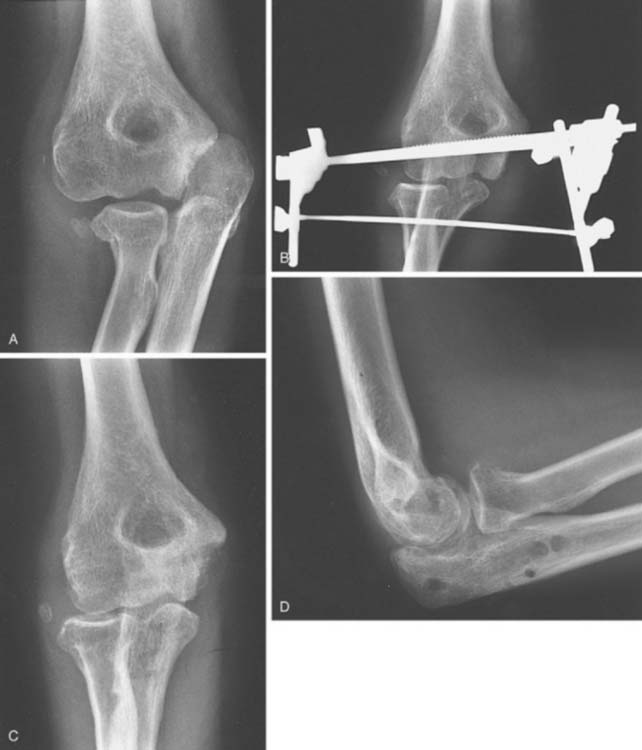CHAPTER 30 Chronic Unreduced Elbow Dislocation
INTRODUCTION
Elbow instability in one form or another remains one of the most vexing of all expressions of elbow trauma. The spectrum of elbow instability is carefully addressed in the pediatric patient (see Chapter 20), simple and complex instability in the adult (see Chapters 28 and 29), and in the chapter on external fixation for the elbow (see Chapter 33). The instability addressed in this chapter is termed chronic unreduced complete dislocation. A chronic unreduced dislocation is very uncommon in this country and is principally seen in Third World nations. Thus, much of our understanding has come from contributions from South Africa, Thailand, and India.8,10,11,14,17,18
CHRONIC UNREDUCED ELBOW JOINT
The simplest way to consider the two major types of chronic unreduced elbow joints is that of subluxation, or complete dislocation. The most common of these is sometimes a subtle chronic posterior subluxation due to fracture of the coronoid. This chronic instability pattern is dealt with in the chapter on complex instability (see Chapter 29). The chronically unreduced complete dislocation is not common, so few have much experience dealing with it. The second is an unreduced complete dislocation, which is rare except, as mentioned earlier, in underdeveloped countries.
PRESENTATION
Chronic unreduced complete dislocation has the following characteristics: (1) gross deformity; (2) variable motion from complete ankylosis in approximately one third of cases to a near-functional arc of motion of greater than 40 degrees in one third, and motion between 0 to 40 degrees in the remaining one third13; (3) pain ranges from minimal to significant depending on the duration of the dislocation with marked individual variation.
OCCURRENCE AND CLINICAL PRESENTATION
At presentation, about two thirds have unacceptable function due to instability, pain, or both.13 The frequency is highly dependent on the local medical customs dealing with the initial dislocation, experience, expertise, and expectation. The presence of traditional medical care (bone setters3) explains the reports from Africa documenting large series (81 cases over a 10-year period).14 In Thailand, 135 patients were reported in a 15-year period from three hospitals.10 The deformity may occur both in children and in adults. These patients have often sustained an associated fracture as well. Naidoo14 noted that 13 of 23 patients undergoing treatment had an associated fracture. A similar rate of 45% (62 of 135) was reported from a large multicenter study by Mahaisavariya and associates.10 About 50% simply have a posteriorly displaced, complete dislocation. The patients usually do not have neurologic deficit at the time of presentation, but if there is neural impairment, the ulnar nerve is most commonly symptomatic. Vascular compromise is extremely rare.
TREATMENT
The choice of treatment has been predicated on the age of the patient, the timing of the intervention, and the likelihood of successful reduction. The full spectrum of reconstructive options has been suggested as a treatment for the neglected dislocation. These options include reduction, reduction and interposition, resection, fusion, and replacement. Resection is not a viable option today. In most practices and circumstances, fusion might be considered, but this is not usually considered in the United States. The techniques of interposition and replacement arthroplasty are discussed elsewhere (see Chapters 69 and 70). An attempt at closed reduction is reasonable at all ages for dislocations of less than 3 weeks’ duration. Today, this is particularly effective with the added stability provided by an external fixation.9,18 Although fusion and resection have both been considered for the chronic condition,2,4,6 by far the most logical and accepted approach is open reduction (Fig. 30-1). Although this recommendation has been somewhat controversial in the past, open reduction outcomes are as good or better than other options and is effective years after injury.5,11
Here we will review only the treatment strategy for open reduction. The use of an external fixation is discussed in Chapter 33. Joint replacement is recommended in patients older than 60 years of age and is discussed in Chapter 59. The surgical approach is predicated onan understanding of the pathology and a flexible surgical treatment plan.
SURGICAL TECHNIQUE
The surgical technique preferred by the author specifically addresses the pathology according to a defined sequence (Fig. 30-2).








